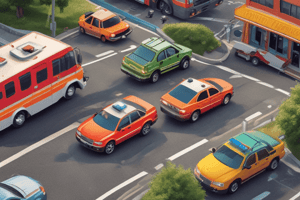Podcast
Questions and Answers
What does 'Right of Way' imply?
What does 'Right of Way' imply?
- You can be fined
- Yield for other drivers
- Both A and B (correct)
- None of the above
What is a Traditional intersection?
What is a Traditional intersection?
Two or more users of the roadway meet, controlled or uncontrolled.
What defines Non-traditional intersections?
What defines Non-traditional intersections?
Meet at turnabout or railroad crossing.
What are Controlled intersections characterized by?
What are Controlled intersections characterized by?
What should you yield to at Uncontrolled intersections?
What should you yield to at Uncontrolled intersections?
How do paved roads relate to unpaved roads?
How do paved roads relate to unpaved roads?
What right of way do T intersections give?
What right of way do T intersections give?
What should you do when approaching train crossings?
What should you do when approaching train crossings?
Who has the right of way during left turns?
Who has the right of way during left turns?
What is the definition of a private road?
What is the definition of a private road?
What should you do when you see emergency vehicles?
What should you do when you see emergency vehicles?
What do school buses need to do when their lights are flashing?
What do school buses need to do when their lights are flashing?
When don't school buses need to stop?
When don't school buses need to stop?
What does a red light indicate?
What does a red light indicate?
A flashing red light means you can continue through without stopping.
A flashing red light means you can continue through without stopping.
What does yellow signify in traffic signals?
What does yellow signify in traffic signals?
What does a flashing yellow light require?
What does a flashing yellow light require?
What does a yellow arrow indicate?
What does a yellow arrow indicate?
What should you do when the light turns green?
What should you do when the light turns green?
What do the colors of traffic signs indicate?
What do the colors of traffic signs indicate?
What does the shape of traffic signs indicate?
What does the shape of traffic signs indicate?
Flashcards are hidden until you start studying
Study Notes
Right of Way
- Right of way violations can result in fines; yielding is crucial for safety on the road.
- Drivers at controlled intersections must yield to vehicles already present or those to their right.
Intersections
- Traditional Intersections: Where two or more roadway users converge, can be controlled (with signs) or uncontrolled (no signs).
- Non-Traditional Intersections: Locations such as turnarounds or railroad crossings with unique traffic considerations.
- Controlled Intersections: Governed by traffic signs; prioritize yielding to existing intersection traffic and the driver on the right.
- Uncontrolled Intersections: Require yielding to the driver on the right due to absence of regulatory signs.
Special Road Types
- Unpaved Roads: Paved roads generally have the right of way over unpaved roads.
- T Intersections: Vehicles on the cross street have the right of way.
Train Crossings
- Approach train crossings with caution and respect signal warnings, gates, or flags; keep a safe distance (at least 1500 feet).
- Always remain vigilant around train tracks to prevent accidents.
Emergency Vehicles
- When encountering emergency vehicles with sirens and lights, create space by moving to the right and reducing speed to 25 mph less than the speed limit.
- Pull over to assist emergency vehicles in passing safely.
School Buses
- School buses with flashing lights require all traffic to stop until the lights cease and the bus resumes motion.
- Buses do not need to stop if they are on a different road, using access roads, or whether traffic is moving in the opposite direction.
Traffic Signals
- Red Light: Requires a complete stop; right turns may be made unless prohibited, left turns allowed only on one-way streets unless signage indicates otherwise.
- Flashing Red Light: Mandates a complete stop at the intersection.
- Yellow Light: Indicates caution, signaling that a light will change soon.
- Flashing Yellow Light: Drivers should yield to oncoming traffic without requiring a complete stop.
- Yellow Arrow: Advises caution while turning left, indicating potential changes in light state.
Green Light
- Upon a green light, drivers should check for oncoming traffic from both right and left before proceeding.
Traffic Sign Characteristics
- Color: Each color on traffic signs conveys specific meanings and instructions.
- Shape: The shape of traffic signs is also critical for understanding important regulations and warnings.
Studying That Suits You
Use AI to generate personalized quizzes and flashcards to suit your learning preferences.




